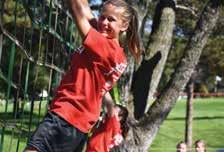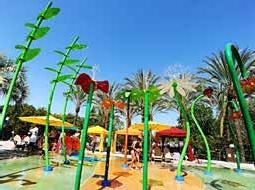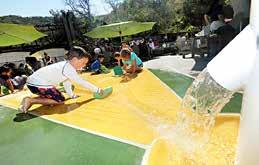
13 minute read
RESEARCH REVIEW: WHAT EVERY PRACTIONER SHOULD KNOW ABOUT YOUTH SPORTS SPECIALIZATION
R E S E A R C H R E V I E W
A Balancing Act: What Every Practitioner Should Know About Youth Sport Specialization
Researchers: Keri Schwab, Megan Bonwell, Brian Greenwood, and Anna Levine. California Polytechnic University, San Luis Obispo
Youth sport specialization has become increasingly popular in the United States in recent years (Buckley, et al., 2017). Many young athletes attempt to specialize in a single sport in hopes of obtaining collegiate scholarships or ‘going pro’ in the future. While intense, single sport participation can have benefits, but there can also be negative consequences. The purpose of this study was to understand positive and negative experiences and perceived outcomes of single sport specialization among young adults, several years after ending their intense sport participation.
Background
Youth sport participation can lead to physical, cognitive, and emotional benefits, however it is not clear if specializing in a single sport through intense participation can add to or detract from those benefits. Specialization is when a young athlete, age 10-18, trains and competes in a single sport, and at the exclusion of all other sports, for at least eight months of the year (Capranica & Millard-Stafford, 2011). Physical benefits of youth sport are numerous and include improved sport-specific abilities (i.e., hand-eye coordination) and generally improved physical fitness (Myer et al., 2015). When young athletes work in team environments, they may improve their social and interpersonal skills, such as communication, conflict resolution, and teamwork. Participation in youth sports can also foster social values like caring, empathy, and compassion (Bailey, 2005). Studies have also found that participation in both individual and team sports can lower social anxiety (Dimech & Seiler, 2011), decrease feelings of social isolation (Barber, Eccles, & Stone, 2001), and improve self-esteem (Pedersen & Siedman, 2004). Young athletes may then experience improved wellbeing and mental health, likely from increased social opportunities and support (Jewett et al., 2014).
While there are numerous benefits attributed to youth sport participation, there can also be negative consequences. Consistent year-round training in a single sport can hinder physical, social, and emotional benefits. Such intense training can result in overuse injuries, and physical and mental burnout (DiFiori et al., 2014). Intense training also requires substantial time after school and during the weekends. Such a demanding schedule can result in missed social and educational opportunities, which can then hinder relationship building and social skills, and lead to poor self-concept (Ferguson & Stern, 2014; Russell & Limle, 2013). Intense training can also result in chronic stress, loss of motivation, burnout, and mood disturbances, all of which can ultimately lead to dropout from youth sports (Goodger, Gorely, Lavallee & Harwood, 2007; Goodger, Wolfenden & Lavallee, 2007). Fortunately, some of these negative consequences can be mitigated by the motivational climate created by the coach, and the support of parents, caregivers, and peers.
The motivational climate of a sports team can greatly impact the young athlete’s experience. Much research has examined types of motivational climates and the coach’s role in creating that environment. Overall, studies indicate that a task or masteryfocused climate rather than an ego or performance-focused climate is more likely to foster positive outcomes of youth sport participation. In a taskfocused climate, the emphasis is on skill development, improvement, effort, and learning (Newton, Duda, & Yin, 2000). In such a climate, youth are more likely to feel enjoyment and competence, try hard, develop intrinsic interest, and persist in sport over time (Reinboth & Duda, 2006; van de Pol, Kavussanu & Ring, 2012). In a performance-focused climate, which emphasizes individual success and ego, young athletes are more likely to feel competitive with their teammates and engage in judgment and social comparison of their peers (Newton et al., 2000). Studies have found that youth in a performance-focused climate experience more tension, less enjoyment, and ultimately reduced effort, performance, and persistence (Van de Pol et al., 2012).
Methods
Researchers conducted open-ended interviews in order to gather rich, descriptive data from former youth sport specializers regarding their sport experience. Interviews are useful for gaining a deeper understanding of a sport psychology or sport-related phenomenon (i.e., Pynn, Dunn, & Holt, 2018). Researchers created interview questions based on youth sport and motivational climate literature. Interviewees were found through snowball sampling and had to meet the youth sport specializer criteria of having played in one sport, at the exclusion of other sports, for at least eight months of a year for at least one year between the ages of 10 and 17, and no longer participated in that sport. Researchers conducted 25 interviews that lasted 45-60 minutes, during which they asked about interviewee demographics, general sport experience, relationship with coaches, teammates, and parents, the decision to leave the sport, and the former athletes’ connection with the sport or physical activity now. Interviews were transcribed verbatim and independently coded for emergent themes by two researchers.
Results
From the 25 interviews, results are organized into two major areas; Benefits and Burnout. At the time of the interviews, the former youth athletes had an average age of 21.1 years old and had played their sport an average of 10.9 years. Six interviewees identified as male, 19 identified as female. Soccer was the most common sport, with 10 interviewees having played it, followed by swimming (3), dance (2) and then one each for several other sports including volleyball, cheerleading, track, skiing, water polo and field hockey.
Benefits
Benefits espoused by the former athletes centered on a theme of selfimprovement through sport. Enhancement of personal time management, ability to work in teams, conflict resolution, and emotional control were all mentioned. One former youth athlete said, “I am very good at balancing a lot of things, and I think that was because I had to learn that at 10 years old when I was spending a lot of time in the gym and still had school.” Interviewees also talked about learning how to work with people with different perspectives. Said one, about skills learned then and still used now; “Respect, teamwork and compromise. Conflict resolution is huge.” In addition, athletes experienced emotional development, now useful in professional settings. This was explained as “basically how to keep my emotions in check and be able to put them aside when you need to get something done.”
Interviewees also noted that youth sports helped to develop self-confidence and self-efficacy during their adolescent years. One said sports

helped her learn “to be able to tell yourself that you’re good enough,” and another said sports helped with “believing in yourself and being confident that the work you put in would pay off in the end.”
While all of the interviewees no longer participate in sports competitively, a majority described how being an “athlete” is a major part of their identity, years later. This feeling of continued athleticism led most respondents to remain active in their daily lives and value a healthy lifestyle and physical fitness. Said one; “I think no matter what I’ll always identify as an athlete and a fit person and soccer really just shaped me in that way.”
Coaches, parents and peers also played an influential role in how the former young athletes viewed the experience. Some recalled the powerful impact a positive coaching relationship had on them. One said the relationship helped him grow, “It was the way coaches pushed me and made my work ethic even better,” and another said their coach “saw me as a whole and could see the parts that I was struggling with and give me tips on how to fix it.”
Others had negative experiences that ultimately led to their withdrawal from youth sports. One athlete remembered a time when the coach would “… come around and just pick on every little thing,” and another, recalling laps doled out as ‘punishment,’ said, “Punishment makes the environment stressful.” These types of negative experiences through singlesport specialization can naturally lead to negative consequences.
Burnout
The primary element emerging as a negative consequence in this study centered on themes that ultimately resulted in feelings of burnout. The former youth athletes who were interviewed mentioned missed social interactions with friends outside their sport, due to the intense time commitment required by sport specialization. One said she would ask herself: “Why am I doing this, what is the purpose? I want to be going to the pool with my friends and have sleepovers and I don’t want to go the gym at 7 or 8am.”
Another negative element was the mental and physical exhaustion experienced, which often led to a lack of motivation and eventual overall burnout. One interviewee described her frustration; “I wasn’t getting better and I was trying hard at that point.” Another summed up both the missed social interactions and the physical burnout as, “At the end of my career I definitely think I was burnt out and would go to the gym crying, begging my mom not to make me go that day, and I just wanted to go home and I didn’t want to do it anymore.”
Application
It is important for youth sport practitioners to recognize that youth sport can yield numerous benefits but also can have negative consequences for participants. While early specialization might be right for one child, it could be detrimental for another. For youth who do participate in high intensity competitive environments, and in an ego or performance-focused climate, they might experience physical and mental exhaustion, injury, frustration, missed social connections, and general burnout. Adults involved in a child’s life should consider if ‘going pro’ is a realistic outcome of intense sport specialization, and if it is worth the loss of social and extracurricular opportunities.
Benefits reported by subjects in this study were not necessarily attributed to intense participation. Benefits such as time management and emotional regulation could be learned from moderate sport participation. The negative impact of sport specialization, however, was often attributed to the intense training and competing schedule. A more balanced approach to youth sport participation could be sampling.
Sampling is trying different, often loosely structured activities, and usually with minimal adult supervision. In sampling, youth are afforded opportunities to build physical and cognitive skills as meets their current needs and interests. Sampling is a good way to foster confidence and competence in a child, as well as intrinsic motivation to be active (Côté, Baker, & Abernethy, 2007). Those who sample are more likely to have stronger family and community connections, and a greater sense of social capital (Côté, Horton, MacDonald, & Wilkes, 2009; Strachan, Côté, & Deakin, 2009). Recreation practitioners can support sampling by offering one-time workshops in which youth can try a new activity once or twice but without committing time or money to a long program.
There are a few other ways to balance intense or moderate youth sport specialization or participation. Adults could support and provide additional free time outside of sport training and school to allow a child to make social connections and establish a larger and more diverse group of friends. Such additional free time could improve an athlete’s social abilities and diversify their friend group as they navigate the highly social (and sometimes awkward) adolescent years. To reduce the mental and physical exhaustion that some young athletes experience, adults could provide time outside of school and sports, such as summer vacation, to allow even more unstructured free time to fill with family, friends, hobbies, or personal passions.
While there are many benefits to youth sport participation, programmers, parents, and coaches should be aware of the potential negative consequences of intense specialization and consider offering youth options to sample and learn a variety of sports, with a more diverse group of peers and coaching styles.
References
Bailey, R. P. (2005). Evaluating the Relationship Between Physical Education, Sport, and Social Inclusion. Education Review, 57(1), 71–90. https://doi.org /10.1080/0013191042000274196
Barber, B., Eccles, J., & Stone, M. (2001). Whatever happened to the jock, the brain, and the princess? Young adult pathways linked
to adolescent activity involvement and social identity. Journal of Adolescent Research, 16(5), 429–455. doi:10.1177/0743558401165002
Buckley, P. S., Bishop, M., Kane, P., Ciccotti, M. C., Selverian, S., Exume, D., … Ciccotti, M.
G. (2017). Early single-sport specialization: A survey of 3090 high school, collegiate, and professional athletes. Orthopaedic Journal of Sports Medicine, 5(7). doi:10.1177/2325967117703944
Capranica, L., & Millard-Stafford, M. L. (2011). Youth sport specialization: how to manage competition and training?. International journal of sports physiology and performance, 6(4), 572-579.
Côté, J., Baker, J., & Abernethy, B. (2007). Practice and play in the development of sport expertise. In G. Tenenbaum & R.C. Eklund (Eds.), Handbook of sport psychology (pp. 184–202). Hoboken, NJ: Wiley.
Coté, J., Horton, S., MacDonald, D., & Wilkes, S. (2009). The benefits of sampling sports during childhood. Physical & Health Education Journal, 74(4), 6-11. Retrieved from https:// journal.phecanada.ca/
DiFiori, J. P., Benjamin, H. J., Brenner, J. S., Gregory, A., Jayanthi, N., Landry, G. L., & Luke, A. (2014). Overuse injuries and burnout in youth sports: a position statement from the American Medical Society for Sports Medicine. Br J Sports Med, 48(4), 287-288.
Dimech, A., & Seiler, R. (2011). Extracurricular sport participation: A potential buffer against social anxiety symptoms in primary school children. Psychology of Sport and Exercise, 12(4), 347–354. doi:10.1016/j.psychsport.2011.03.007
Ferguson, B., & Stern, P. J. (2014). A case of early sports specialization in an adolescent athlete. The Journal of the Canadian Chiropractic Association, 58(4), 377-383. Retrieved from https://www.chiropractic.ca/jcca-online/
Goodger, K., Gorely, T., Lavallee, D., & Harwood, C. (2007). Burnout in sport: A systematic review. The Sport Psychologist. 21(2),127-151. doi:10.1123/tsp.21.2.127
Goodger, K., Wolfenden, L., & Lavallee, D. (2007). Symptoms and consequences associated with three dimensions of burnout in junior tennis players. International Journal of Sport Psychology. 38(4), 342-344.
Jewett, R., Sabiston, C. M., Brunet, J., O’Loughlin, E. K., Scarapicchia, T., & O’Loughlin, J. (2014). School sport participation during adolescence and mental health in early adulthood. Journal of adolescent health, 55(5), 640-644.
Myer, G. D., Jayanthi, N., Difiori, J. P., Faigenbaum, A. D., Kiefer, A. W., Logerstedt, D., & Micheli, L. J. (2015). Sport specialization, part I: Does early sports specialization increase negative outcomes and reduce the opportunity for success in young athletes? Sports Health: A Multidisciplinary Approach, 7(5), 437–442. doi:10.1177/1941738115598747
Newton, M., Duda, J. L., & Yin, Z. (2000). Examination of the psychometric properties of the perceived motivational climate in sport questionnaire-2 in a sample of female athletes. Journal of Sports Sciences, 18, 275–290. doi:10.1080/026404100365018
Pedersen S, & Siedman, E. (2004). Team sports achievement and self-esteem development among urban adolescent girls. Psychology of Women Quarterly. 28(4), 412–422. doi:10.1111/j.1471-6402.2004.00158.x
Pynn, S. R., Dunn, J. G., & Holt, N. L. (2018). A qualitative study of exemplary parenting in competitive female youth team sport. Sport, Exercise, and Performance Psychology, 7(1), 1-16. doi:10.1037/spy0000141
Reinboth, M., & Duda, J. L. (2006). Perceived motivational climate, need satisfaction and indices of well-being in team sports: A longitudinal perspective. Psychology of Sport and Exercise, 7, 269–286. doi:10.1016/j. psychsport.2005.06.002
Russell, W. D., & Limle, A. N. (2013). The relationship between youth sport specialization and involvement in sport and physical activity in young adulthood. Journal of Sport Behavior, 36(1).
Strachan, L., Côté, J., & Deakin, J. (2009). “Specializers” versus “samplers” in youth sport: Comparing experiences and outcomes. The Sport Psychologist, 23(1), 77-92. doi:10.1123/ tsp.23.1.77
Van de Pol, P. K., Kavussanu, M., & Ring, C. (2012). Goal orientations, perceived motivational climate, and motivational outcomes in football: A comparison between training and competition contexts. Psychology of Sport and Exercise, 13, 491–499. doi:10.1016/j.psychsport.2011.12.002
Gilroy Gardens Splash Pad, Gilroy

Mackay Park Picnic & Play, Cypress Pedestrian & Bicycle Paths Long Beach Mackay Park Rain Water Catchment, Cypress


HAI
Gilroy Gardens Water Journey, Gilroy

Patrick Hirsch
President pat@hailandarch.com 714.776.4340
Hirsch & Associates, Inc.
Landscape Architecture & Planning Charles Foley
Vice President chuck@hailandarch.com www.hailandarch.com




